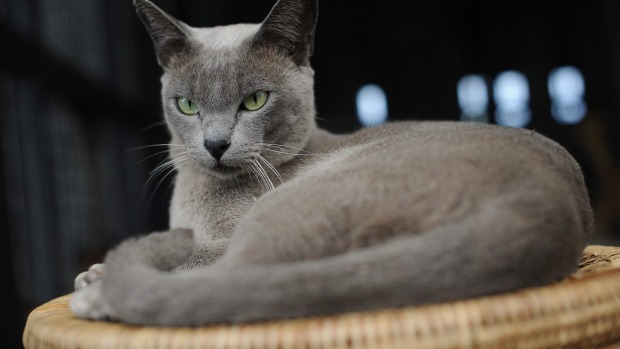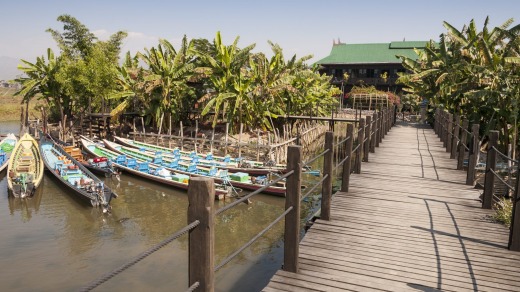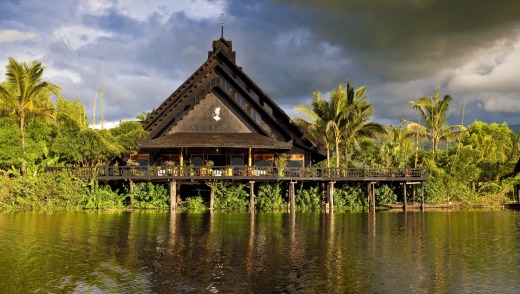
Sun pours through wooden slats onto a large teak throne. Golden eyes blink in our direction. There are cats, lots of cats. They slink down to meet us, head-butting our bare legs and purring, in shades of chocolate, blue-grey and champagne.
But these are no ordinary cats, they are pure Burmese – high maintenance cats that have been reincarnated in Myanmar, thanks to breeders in Australia and Britain.
They are Burma's returning royalty: the breed that died out when Burma gained independence from the British in 1948 and the Brits took their aristocats home, leaving what was left of the sacred temple guardians to mix with other breeds, the pedigree lost forever.

While most present-day Burmese have never heard of their own special cat breed, it took a French-trained local hotelier and a Hong Kong businessman to reintroduce the cats to Burma through its programme at the aptly named Princess Resort on Inle Lake in Shan state.
But first they had to source pure Burmese stock. Just seven cats made the grade, four from Australia and three from Harrods department store in London.
We'd booked the tour in advance. It sounded intriguing, a visit to a house where Burmese cats are bred. I'd expected a smelly cattery with cages of moth-eaten moggies. Instead it's miniature palaces on stilts for the glossy-coated cats.

We catch the boat early, before the sun rises too high, with our guide Sandi Maung Maung and a boatman in a pork pie hat. The long, canoe-shaped motorboat speeds out of town to a natural lake so vast it's like being at sea, a very calm sea. The air is shiny and clean, a relief after the dusty lanes of the town, the shallow water, clear and cold with long green weed visible just below the surface.
The boatman slows as we approach the jetty and Sandi takes us to meet local cat lover Chaw Su, who manages the program for her benefactor, Yin Yu Su, and Wan Hong Lu of the Hong Kong-based China Exploration and Research Society.
Chaw Su is tiny and delicate and not unlike a cat herself. She tells us the history of the cat home.
"From the time of the Second World War we could not find any more pure Burmese cats in our country," Chaw Su explains. "Our owner wanted to reintroduce them to our country. So we started this project back in 2008."
"In Burma we started to breed the cats here at the Inle Princess Resort. We keep all of the cats here."
Burmese cats are known to have existed for more than a thousand years. The Burmese royal families kept them as pets and others were revered as temple cats and even oracles.
"King Thibaw at the palace had 40 cats," Chaw Su says. The hapless king, Burma's last monarch, was toppled by a British expeditionary force in 1885 and sent with his family into exile in India. The royal cats were left behind.
"The British looked after some of them, according to the history that we know," she says.
Prized for their beauty and their intelligence, the aristocats are pampered accordingly, and ironically, they sleep in tiny replicas of King Thibaw's Mandalay palace.
And like royalty, the true bloods are kept in isolation to preserve their purity, hence their island home on stilts in the middle of Inle Lake. The Burmese can't get out and strays cannot get in.
In the daytime some loll on their mini verandahs, eyeing the ducks in the surrounding waters of their home. But like all cats they love company. "Would you like to see them?" Chaw Su whispers. We follow her through heavy double doors to the cats' domain. There is silence as they survey their latest visitors.
I bend down to stroke a "princess" female cat. She holds my gaze. Her perfect cat face is a heart. Others line up to be stroked and petted. A solitary Tom begins to wail.
"They are famous for their personality," Chaw Su says.
"They are very calm and very intelligent. When we are not taking care of them very well, after about a week they are very sick. They are fragile. They are like a baby actually. They live between 17 and 20 years. "
Each cat's progress is marked on a wall chart. Servants, with dustpan and brush, trail their charges after mealtimes. It is a tightly controlled environment but the programme is working, Chaw Su says.
From the original seven, the cats now number 39: there are four toms, seven queens, 12 castrated and 16 spayed.
"We have 39 cats," she says. "The oldest is seven years, the youngest is six months. We have a honeymoon room," she laughs. "Sometimes I stay with them. They love to sit on your shoulders."
As if on cue a young attendant, her face daubed with Myanmar's traditional sunblock called thanakha, crouches down and a chocolate cat leaps on to her shoulder. She starts to pat its back like a baby. It flexes its claws with pleasure, eyeing us from its vantage point.
Most of the cats are the classic Burmese chocolate. There are also blue, lilac and champagne but, always, Chaw Su says, "the eyes are golden yellow colour".
"When you first look they are a little bit similar to the Siamese cat, but they have a different eye colour the Siamese have blue eyes. And their ear tips are a more dark chocolate than the Siamese," she says.
More than 2000 tourists visited the cat village in December at the height of Myanmar's tourist season.
"We invite the local people also," Chaw Su says. "This year they are starting to come. Until 2012 people in our country did not know about the Burmese cat. They never see and they never know. In 2012, I went to Yangon and had a press show about how the cat was being reintroduced into the country.
"Even now very few people know about the Burmese cat."
Undoubtedly it will be the new wealthy who take up pet ownership of these prized pedigrees one day. While hybrid strays are to be found almost everywhere, including Myanmar's many monasteries, most cat people, living in one of south-east Asia's poorest countries, will have to make do with the humble street moggie.
smartraveller.gov.au/zw-cgi/view/advice/Burma
You will need to apply for a visa at least a month before your trip, see mecanberra.com.au/.
Fly to Yangon via Singapore, Bangkok and Kuala Lumpur from Sydney and Melbourne. See airasia.com; jetstar.com; singaporeair.com; malaysiaairlines.com; thaiairways.com
Domestic airlines fly to Heho (one hour from Yangon), then take a taxi to Nyaung Shwe town then a motor boat to Inpawkhon Village on Inle Lake.
La Maison Birmane, Mingalabar quarter, Nyaung Shwe. Stylish thatch and teak bungalows around a courtyard. Rooms from about $195 per night. See lamaisonbirmane.com/
Inthar Heritage House, Inpawkhon Village. Daily entry to see the cats is free but you can donate by buying locally made cat-themed wares at a small shop on the premises.
While on the lake you can visit floating vegetable gardens, a cheroot factory and attend a Shan cooking class. Book through your guide.
La Maison Birmane has simple but safe food including lentil soup, curries and grilled chicken. It also serves cocktails and local wines.